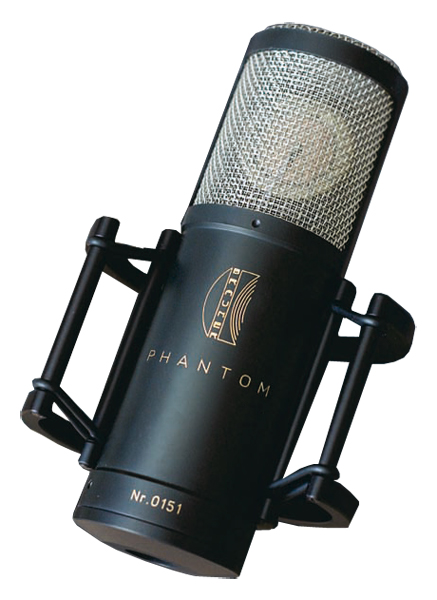
Sound On Sound Review:
Dirk Brauner Röhrengerätemanufaktur (the big word means ‘tube equipment manufacturers’) was a company set up originally to design and build specialist valve-based audio equipment, and to service and modify vintage pro-audio devices. I first came across Brauner microphones about five years ago when I reviewed the then-brand-new VM1 large-diaphragm capacitor mic — a hand-built capacitor microphone with a valve amplifier. Since that first, impressive, beginning the company’s product portfolio has expanded to include a small range of models, all valve based until now.
The latest addition to the Brauner family is the new Phantom, a stylish externally-biased capacitor microphone which employs, for the first time in Brauner’s catalogue, solid-state electronics. The external styling of the microphone is almost identical to Brauner’s Valvet and it is supplied complete with a simple but brilliantly clever shock-mount design. In fact, the engineering of the whole microphone is typically Germanic: solid, efficient, reliable, and expensive — although, for a hand-built microphone of this quality, the UK pricing actually represents value for money if you can justify buying at this end of the market.
The capsule is the same as that used in all the Brauner models. However, the VM1 and Valvet use external power supplies, from which the polar pattern can be controlled (continuously variable in the case of the VM1, and switched between cardioid and omni in the Valvet). The Phantom requires no external PSU, so the body of the mic has been modified to incorporate two miniature toggle switches just below the grille. One selects from three polar patterns (omni, cardioid or figure-of-eight), while the second introduces a 10dB pad.
The microphone measures about 170mm in length and its body is almost a perfect cylinder, 50mm in diameter. A male output XLR is incorporated at the bottom of the body and a serial number (004 in the case of the review model) inscribed below the Brauner logo and model name, which also identify the front of the mic. The case has a plain silver-metal finish, and the capsule is protected behind a double-layer wire mesh grille which occupies the top third of the body.
The suspension cradle is constructed from pairs of upper and lower C-shaped arms, linked to each other by metal rods. The inner and outer cradle are coupled to each other via six rubber rings which provide the isolation. The inner arms wrap just beyond the half-way point of the microphone’s circumference, so that the microphone snaps into place and is held firmly by the suspension rings. As I said, a very ingenious engineering solution.
The stand bracket is equally well engineered, with a long plastic lever arm to ensure that sufficient tension can be applied to the pivot lock. A 3/8-inch adaptor is supplied for the 5/8-inch standard threaded stand socket.
The technical specifications of the Phantom are every bit as impressive as you would expect from a company of Brauner’s reputation. The microphone’s internal amplifier draws a reasonable 4mA of current from the phantom power supply, and produces a self-noise of a very respectable 8dBA. The capsule can tolerate an SPL of 142dB for just 0.5 percent distortion, and provides a healthy output of 28mV/Pa. Frequency response is quoted as extending between 20Hz and 22kHz, although no limits are given. Since the capsule is the same as that in the Valvet, all the specs are identical between the two models, except that the Phantom’s noise performance is 3dB better

 Follow
Follow